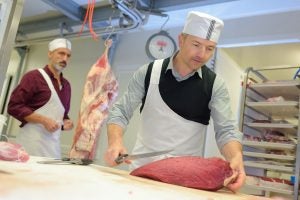Here’s the thing: If there is anything beneficial about America’s food supply chains being disrupted and the pandemic tearing the world apart, it’s that Americans have a greater appreciation for their food and where it comes from.
Most people are used to getting whatever they want and as much as they want at the grocery store without a second thought. While the public’s interest in their food sources has been changing over the past few years, COVID-19 has kicked it into overdrive. Now that some have experienced shortages or purchasing limits, people are waking up to the origins and accessibility of their meat.
Purchasing meat from the grocery store is a perfectly fine way of obtaining it. That’s what most do — and they spend $961 per year on it, on average. That number shifts based on age of the consumer, family size, region, and income.
By purchasing from a local producer for less than what you would normally spend in a year, you can customize your cuts, get high quality meat, know what your animal ate, and maybe even pick the steer that will be on your plate, if you’re into that.
If you have never bought entire carcasses before it can be an intimidating idea to have a steer, hog, lamb, or 10 chickens in your freezer. This method of getting meat for you or your family is also more money upfront and requires a lot of freezer space. Luckily, it’s not nearly as daunting if you follow this easy guide.
1. Find a farmer
This is the part that takes some research. Everyone has been spending more time on the internet, including farmers who want to sell their livestock. If one farmer can’t help you, ask if they have friends — they probably do and would be happy to pass along their information.
2. Ask lots of questions
Ask the farmer the following questions as they are applicable:
- How old is this animal?
- What was this animal fed?
- Can I pick my animal?
- Can I come see your farm? *remember to socially distance!
- Do you know a good butcher?
Chances are they have an established relationship with a butcher or packer. If not, find a local butcher shop or a friend who hunts and/or is handy with knives.

3. Place your order
You don’t have to buy an entire animal if you don’t want to. Especially the larger animals like steers, hogs, and lambs can take up more room than you can spare. Split the cost with family members or friends; or ask the farmer if they have someone who is looking for someone to split with.
At this stage you can talk with the butcher to find the exact cuts you can get from one animal. The entire hog isn’t made of pork chops or the entire chicken made from drumsticks. Here are some quick guides for beef, pork, chicken, and lamb to get you started.
Cuts that require more processing like bacon or sausage will probably cost extra, but you’ll still get it cheaper than you could at the store. Sometimes you can get jalapenos, cheese, or bacon mixed into your ground beef for burgers, which I highly recommend.
You can also get some specialty items like bones, hooves, organs, tongues, tails, and ears for creative eating or pet toys. If you get a steer or a lamb, you can have the hide sent to a tanner to make a lovely rug.
4. Get delicious meat in your freezer
Work with the butcher to get your meat delivered or prepared for pickup. A deep freezer is best for long-term storage (over a year-long period, for example). Then, when you’re ready for a steak, burger, rack, shoulder roast, or whatever your heart desires, reach into the freezer and have local meat ready to thaw.
Jessy Woodworth is a graduate of The Ohio State University, where she studied agricultural communication and animal sciences.



